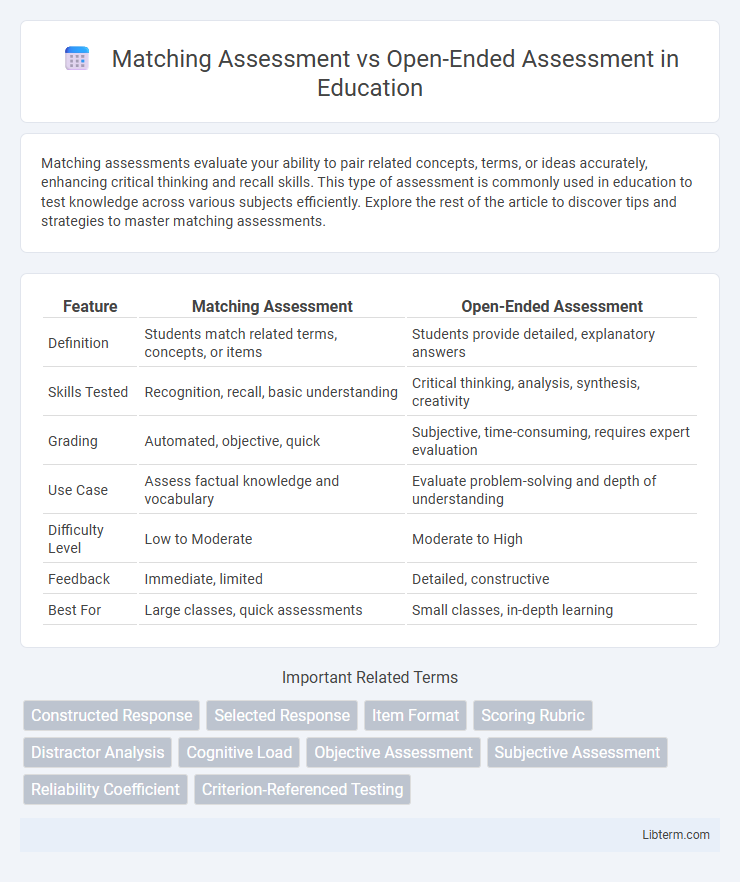Matching assessments evaluate your ability to pair related concepts, terms, or ideas accurately, enhancing critical thinking and recall skills. This type of assessment is commonly used in education to test knowledge across various subjects efficiently. Explore the rest of the article to discover tips and strategies to master matching assessments.
Table of Comparison
| Feature | Matching Assessment | Open-Ended Assessment |
|---|---|---|
| Definition | Students match related terms, concepts, or items | Students provide detailed, explanatory answers |
| Skills Tested | Recognition, recall, basic understanding | Critical thinking, analysis, synthesis, creativity |
| Grading | Automated, objective, quick | Subjective, time-consuming, requires expert evaluation |
| Use Case | Assess factual knowledge and vocabulary | Evaluate problem-solving and depth of understanding |
| Difficulty Level | Low to Moderate | Moderate to High |
| Feedback | Immediate, limited | Detailed, constructive |
| Best For | Large classes, quick assessments | Small classes, in-depth learning |
Introduction to Assessment Types
Matching assessment involves pairing related items, offering efficient evaluation of recognition and recall skills, while open-ended assessment requires students to generate detailed responses, promoting critical thinking and deeper understanding. Both types serve distinct educational purposes: matching tests assess specific knowledge quickly, whereas open-ended questions evaluate reasoning, synthesis, and expressive abilities. Selecting between these assessment types depends on instructional goals, content complexity, and the level of cognitive engagement desired.
Defining Matching Assessments
Matching assessments require students to pair items from two related lists, testing their ability to recognize relationships between concepts or terms. This format is efficient for evaluating factual knowledge, vocabulary, and comprehension in subjects such as language learning, science, and history. Matching assessments provide clear, objective scoring criteria and help instructors quickly identify students' understanding of key material.
Understanding Open-Ended Assessments
Open-ended assessments evaluate critical thinking and deeper understanding by requiring students to create responses without predefined options. These assessments measure the ability to analyze, synthesize, and articulate knowledge, providing richer insights into student comprehension compared to matching assessments. Unlike matching assessments that test recognition and recall, open-ended questions encourage elaboration and personalized expression of learned concepts.
Key Differences Between Matching and Open-Ended Assessments
Matching assessments require students to pair related items, emphasizing recognition and recall through structured response formats, while open-ended assessments demand written or verbal answers that demonstrate critical thinking and depth of understanding. The primary difference lies in response flexibility; matching questions offer limited answer options, facilitating quick scoring, whereas open-ended questions allow for varied, elaborated responses that assess analytical and synthesis skills. Matching assessments are efficient for evaluating factual knowledge, whereas open-ended assessments better measure higher-order cognitive abilities such as problem-solving and explanation.
Advantages of Matching Assessments
Matching assessments offer a streamlined grading process due to their clear answer keys, which significantly reduce subjective judgment and increase scoring reliability. These assessments efficiently measure recognition and recall skills by requiring students to connect related concepts, terms, or facts, facilitating quick knowledge checks in subjects like vocabulary or historical dates. Their structured format supports targeted learning outcomes and allows for rapid feedback, enhancing both teaching efficiency and student comprehension.
Benefits of Open-Ended Assessments
Open-ended assessments encourage critical thinking and creativity by allowing students to express ideas in their own words, fostering deeper understanding. These assessments provide instructors with insights into students' reasoning processes and problem-solving skills that matching assessments cannot capture. The flexibility of open-ended questions supports diverse learning styles and promotes higher-order cognitive skills essential for real-world application.
Best Use Cases for Matching Assessments
Matching assessments excel in evaluating knowledge retention, concept recognition, and understanding of relationships between paired items, making them ideal for vocabulary tests, definitions, and categorization tasks. They provide quick grading scalability for large groups in educational settings and effectively measure associative learning where precise recall of linked concepts is required. These assessments are particularly suited for language learning, science terminology, and foundational skill reinforcement where clear one-to-one correspondences exist.
Situations Where Open-Ended Assessments Excel
Open-ended assessments excel in situations that require critical thinking, creativity, and the demonstration of in-depth understanding, such as essay writing, problem-solving tasks, and research projects. These assessments allow students to articulate their reasoning, explore multiple perspectives, and provide nuanced responses that matching assessments cannot capture. When evaluating complex concepts or skills that go beyond recall, open-ended formats provide richer insights into student learning and mastery.
Choosing the Right Assessment for Learning Outcomes
Matching assessment effectively evaluates recognition and recall skills by requiring students to pair related concepts, making it ideal for measuring factual knowledge and foundational understanding. Open-ended assessment encourages critical thinking and creativity, allowing learners to elaborate on ideas and demonstrate deeper comprehension aligned with complex learning outcomes. Selecting the appropriate assessment hinges on the desired cognitive skills: use matching for objective recall and open-ended questions for assessing analytical and expressive abilities.
Conclusion: Aligning Assessment with Educational Goals
Matching assessment offers efficient evaluation of specific knowledge through objective questions, making it ideal for measuring factual recall and recognition skills. Open-ended assessment allows for deeper insight into critical thinking, creativity, and problem-solving by encouraging elaborate responses aligned with complex learning objectives. Aligning assessment type with educational goals ensures accurate measurement of desired skills, optimizing both teaching effectiveness and student learning outcomes.
Matching Assessment Infographic

 libterm.com
libterm.com